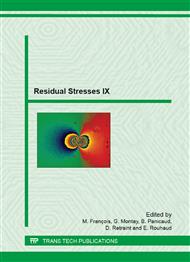[1]
B. Ortner, Simultaneous determination of the lattice constant and elastic strain in cubic single crystals by X-Ray diffraction, Advances in X-Ray Analysis 29(1986) 387-394, Plenum, N. Y.
DOI: 10.1154/s0376030800010491
Google Scholar
[2]
B. Ortner, The choice of lattice planes in X-Ray strain measurement of single crystals, Advances in X-Ray Analysis 29(1986) pp.113-118, Plenum N. Y.
DOI: 10.1154/s0376030800010181
Google Scholar
[3]
H. Dölle, V. Hauk, Einfluß derf mechanischen Anisotropie des Vielkristalls (Textur) auf die röntgenographische Spannungsermittlung, Z. Metallkd. 69 (1979) p.410–417.
DOI: 10.1515/ijmr-1978-690609
Google Scholar
[4]
H. Dölle, The Influence of Multiaxial Stress States, Stress Gradients and Elastic Anisotropy on the Evolution of (Residual) Stresses by X-rays, J. Appl. Cryst. 12(1979) 489–501.
DOI: 10.1107/s0021889879013169
Google Scholar
[5]
S.J. Skrzypek, et al. "New approach to stress analysis based on grazing-incidence X-ray diffraction, J. Appl. Cryst. 34 (2001) 427-435.
DOI: 10.1107/s0021889801005404
Google Scholar
[6]
B. Ortner, Why we should give up the sin2ψ method, Powder Diffraction 24_2-sup (2009) S16-S21.
DOI: 10.1154/1.3139048
Google Scholar
[7]
B. Ortner, Symmetry properties and transformation behaviour of the X-ray stress factors J. Appl. Cryst. 39 (2006) 401_409.
DOI: 10.1107/s0021889806011526
Google Scholar
[8]
S. Haussühl, Physical Properties of crystals, Wiley-VCH, Weinheim, (2007).
Google Scholar


